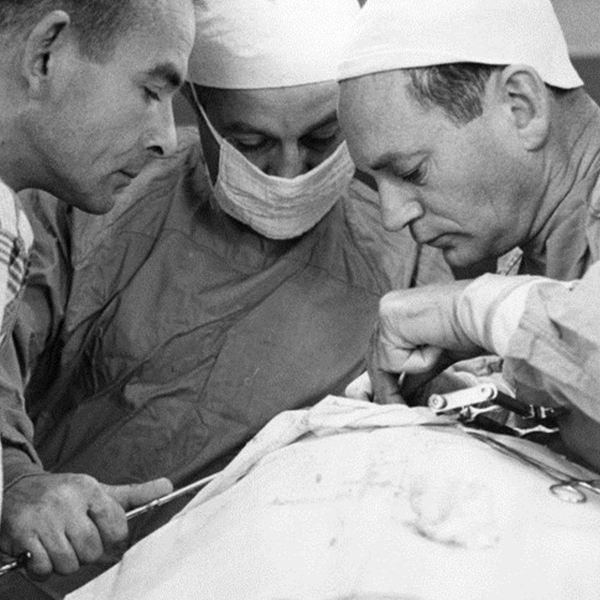
Collaboration
The school—and the profession—gains from the collaboration of Californians who care deeply about animal health and veterinary education. From the outset, the university system, legislators, members of the agricultural community, public agencies and other Californians were instrumental in establishing the school to meet a growing need for veterinarians in the state. Eureka's McGowan family, fruit grower Vincent Garrod and other concerned citizens in the 1930s pressed to establish the veterinary school through a combination of lobbying, planning and supporting the university's administration. Several of the school's initiatives over the years have flourished thanks to loyal supporters. John E. Thurman, Kenneth L. Maddy and other legislators persuaded fellow representatives of the benefits of locating programs at the school, notably, the California Animal Health and Food Safety Laboratory and the Kenneth L. Maddy Equine Analytical Chemistry Laboratory.
With experienced professors, eager new faculty and veterinarians from the public sector, the school built its foundation. The location near state agricultural, health and wildlife agencies and other programs of national stature proved advantageous to the school and persuaded the School of Medicine and the California National Primate Research Center to locate at UC Davis.
Collaboration also began early in the school's research units. In the 1960s, articles on ruminant metabolism and the biosynthesis of cow's milk came about when a faculty member teamed up with an animal scientist to examine amino acids in lactating cows.
Veterinary Medicine Extension specialists in dairy, beef, small ruminant, animal welfare and poultry connected with agricultural advisors and provided practical advice to producers.
The school's first radiologist, trained in human medicine, applied techniques to diagnose hip dysplasia in young dogs, producing a healthy impact on canine breeding. Ensuing generations have brought increasing sophistication to the study of disease and the technology that brings advances in human medicine to the veterinary setting. Fruitful veterinarian-physician collaborations have involved experts in hemodialysis, microsurgery, regenerative medicine, oncology, virology and neurology, to name a few.
Veterinarians bring comprehensive knowledge of animal health to the table when working on projects with agricultural scientists, anthropologists, economists, educators, engineers, entomologists, hydrologists, microbiologists, nutritionists, physicians, toxicologists, public health professionals, sociologists and more. One study of agricultural economics in veterinary medicine in the 1990s provided a convincing estimate of losses to the cattle industry if foot and mouth disease occurred in California—the state and producers immediately put protocols into effect to protect the state's herds.
In the 1990s, the school began administering the Oiled Wildlife Care Network in cooperation with California's Office of Oil Spill Prevention and Response. Supported by industry funding mandated by law, faculty developed proven protocols for coordinated response along the state's 1,100-mile coastline. The veterinary research designed to validate the best treatments for oiled birds and other wildlife has helped the network become an international model. Network leaders have traveled around the world to help manage the care of wildlife injured in oil spills.
In 1998, the school partnered with UC San Diego to extend clinical services and research collaborations in Southern California by establishing the University of California Veterinary Medical Center - San Diego. By 2008, the center was offering specialized services in pharmacy, nutrition, cardiology and kidney medicine, including hemodialysis.
In the curriculum, instructional teams made up of basic and clinical faculty cover course work and its interlocking aspects at the body system level so that students can learn to apply principles of health in the clinical setting.
Patients of the teaching hospital benefit from state-of-the-art veterinary care. In turn, clients contribute directly to the education and training of veterinarians. Working with client-owned animals may also involve cooperative projects with scientific value. The El Blanco Award, established in 1994, recognizes the significant contributions that clients have made to clinical veterinary medicine. Clinical cases have helped faculty uncover the critical importance of taurine in the feline diet, make discoveries in genetics benefiting horses and dogs, and advance dairy cattle health.
Generous donors, often grateful clients, have always supported students, enhanced research programs and funded clinical projects. The estates of Theodora Peigh and Maxine Adler, for example, have provided more than $13 million in scholarships since 1995 for hundreds of veterinary students. Companion animal disease and nutrition research is supported nearly entirely by private donations, including the funding for the $16 million Center for Companion Animal Health. Gifts have also supported faculty research, equipped specialized laboratories, and funded lectureships and graduate fellowships. Such philanthropy has enabled the school to establish endowed chairs in equine and emergency medicine, oncology and genetics.
